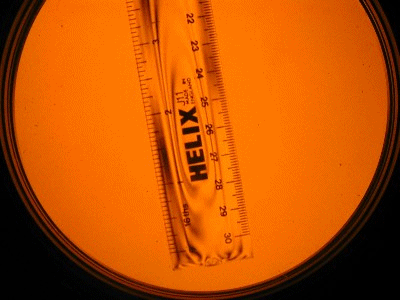Introduction
The photoelastic effect (alternatively called the piezo-optical effect) is the change of refractive index caused by stress. Applications of photoelasticity involve applying a given stress state to a model and utilising the induced birefringence of the material to examine the stress distribution within the model. The magnitude and direction of stresses at any point can be determined by examination of the fringe pattern, and related to the studied structure.
Two different types of fringes can be observed in photoelasticity: isochromatic and isoclinic fringes. Isochromatic fringes are lines of constant principal stress difference, (σP - σQ). If the source light is monochromatic these appear as dark and light fringes, whereas with white light illumination coloured fringes are observed. The difference in principal stresses is related to the birefringence and hence the fringe colour through the Stress-Optic Law.
Isoclinic fringes occur whenever either principal stress direction coincides with the axis of polarisation of the polariser. Isoclinic fringes therefore provide information about the directions of the principal stresses in the model. When combined with the values of (σP - σQ) from the photoelectric stress pattern, isoclinic fringes provide the necessary information for the complete solution of a two-dimensional stress problem.
A standard plane polariscope shows both isochromatic and isoclinic fringes, and this makes quantitative stress analysis difficult.
Isoclinic fringes can be removed by using a circular polariser. Image capturing and digital processing techniques also allow for the separation of the isoclinic and isochromatic fringe patterns. Isoclinic fringes can be observed by reducing the number of isochromatic fringes through either applying a smaller load or by using a material with a high material fringe constant. The two types of fringes can be distinguished by rotating the specimen in a plane polariscope. Isoclinic fringes will vary in intensity during rotation whereas isochromatic fringes will be invariant to the orientation of the specimen with respect to the polariser and analyser.

Plain polariscope images of the same ruler in different orientations. Note the varying intensity of the isoclinic fringes.

